신생아에게 모유수유를 할 때, Breastfeeding to newborn infants
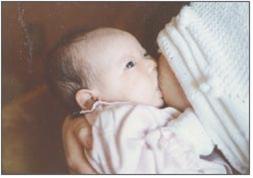
사진 2-70. 모유수유
눈길 접촉 사랑, 신체적 접촉을 하면서 모유를 먹인다.
Copyright ⓒ 2011 John Sangwon Lee, MD., FAAP
- 분만 후 엄마가 건강하고 갓 태어난 아기에게 흡철반사가 있고 대체로 건강하면 출생한 후 바로 어느 때든지 모유수유를 시작할 수 있다.
- 가능하면, 자연분만 후 분만대 위에서도 모유수유를 바로 시작할 수 있다.
- 심지어 제왕절개 수술 분만으로 갓 태어난 아기에게도 수술대 위에서 바로 모유수유를 시작할 수 있다.
- 모유수유를 맨 처음 시작한 후, 매 2∼3시간마다 시간제로 수유할 수 있다.
- 모유수유를 시작할 때 대개 1~2시간 간격으로, 한쪽 젖을 수유하는데 5~7분 동안, 양쪽 젖을 10~15분 정도 걸려 수유할 수 있다.
- 첫 몇 일간 1일 8~12회 수유하기도 한다.
- 한쪽 젖을 먹이는 시간은 각 아기에 따라 다르고, 생후 일령이나 주령, 또는 월령에 따라 다르다.
- 또 하루하루 다르게 모유를 수유할 때도 있다.
- 모유가 원활하게 잘 분비되기 시작하면, 한쪽 젖을 수유하는 데 요하는 평균 시간은 10~20분 정도이고,
- 양쪽 젖을 다 수유하는 데는 20~40분 정도 걸릴 수 있다.
- 때로는 1회분 수유하는데 요하는 총 시간이 40분 이상 조금 더 걸릴 수 있다.
- 모유를 수유하는 것도 일종의 식이 의술이다.
- 모유수유를 공식에 맞춰 일률적으로 할 수 없다.
- 생후 첫 1∼3일 동안 젖이 충분히 분비되지 않더라도 시간에 맞춰 모유를 수유(시간제 수유) 하면 초유가 더 잘 분비되고 그 초유를 아기에게 먹일 수 있다.
- 전이 모유나 성숙 모유가 잘 분비되지 않는 상태에서 아기가 빈 유방의 젖꼭지를 빨면 유선이 자극되어 모유가 더 잘 분비될 수 있다.
- 대부분의 소아청소년과 의사들과 모유를 수유하는 엄마들은 갓 태어난 신생아에게 엄마의 젖만 먹이라고 강조한다.
- 엄마의 젖 이외 다른 아무것도 아기에게 먹이지 말라고 강조한다. 즉 인공영양, 분유, 신생아용 5% 포도당, 맹물도 절대로 먹이지 말라고 강조한다. 하지만, 분만 후 첫 몇 시간 동안, 때로는 분만 후 하루 이틀 동안 초유만 분비되고 그다음 전이 모유가 조금 분비되는 되지만 아주 조금 분비되기도 한다.
- 분만 후 수유모에게 정신적으로 육체적으로 문제가 있든지 불편한 문제들이 알게 모르게 많이 있을 때도 있다.
- 또 그 외 다른 이유로 신생아가 모유를 충분히 섭취할 수 없으면 의사의 지시에 따라 모유가 충분히 분비될 때까지, 또는 수유모의 전반적 건강 상태가 정상으로 회복될 때까지 하루에 한두 번 정도, 또는 며칠 동안 보충용 인공영양(응급용 인공영양)을 아기에게 분별 있게 먹일 수 있다.
- 이런 목적으로 인공영양을 먹이는 방법을 “구조 인공영양 식이 또는 보충용 인공 영양”이라고 한다. 즉 이 때도 식이 예술이 통하게 해야 한다.
- 그러나 분별없이 엄마의 젖도 먹이고 인공영양도 자유자제로 먹이고, 또 모유나 인공영양을 계속 먹이면, 즉 “혼합수유”를 하면, 십 중 팔구는 모유수유를 더 이상 계속 할 수 없게 된다.
- 그래서 “혼합수유를 가능하면 하지 않도록 권장한다. 사실인 즉 “혼합수유”란 말은 쓰지 말아야 한다. 혼합수유는 사실상 “혼동수유”이다.
- “구조 인공영양 식이(보충용 인공영양)” 방법으로 신생아에게 영양분을 먹일 때 모유수유를 더 이상 계속 할 수 없는 경우가 흔히 생길 수 있다. “구조 인공영양 식이”를 시작하기 전에 앞으로 모유수유를 더 이상 할 수 없을 수도 있다는 것을 염두에 두어야 한다.
- 생후 첫 며칠 동안은 한 번 수유하는데 소요되는 시간은 약 10∼15분 정도가 적당하다.
- 그러나 각 아기에 따라, 수유모, 모유의 분비량, 아기의 나이, 즉 일령 등에 따라 매번 모유수유를 하는 데 소요되는 시간을 적절히 조절할 수 있다. ([부모도 반의사가 되어야 한다-소아가정간호 백과]-제 4권 모유, 모유수유, 이유-p 분만 후 아기에게 젖먹이는 요령 참조) 신생아는 태어날 때부터 엄마의 젖을 찾아 먹을 수 있는 원시 반사를 지니고 있다.
- 그 반사를 포유반사(루팅 반사 /먹이 찾기 반사/Rooting reflex)라고 한다. 그 원시 반사인 포유 반사 이 외 다른 원시 반사를 정상적으로 가지고 태어난다.
- 신생아의 입술이나 입 주위, 또는 뺨에 닿으면 엄마의 젖꼭지나 손가락, 고무젖꼭지 등을 입안에 넣고 빨아 먹으려고 닿는 쪽으로 얼굴과 입을 돌리는 원시 반사를 포유반사(루팅 반사)라고 한다.
- 입 안 속으로 들어온 엄마의 젖꼭지 등을 빨아 젖을 먹을 수 있는 원시적 반사가 있다. 이 반사를 흡철 반사(빨기 반사/Sucking reflex)라고 한다.
- 이런 흡철 반사, 포유 반사 등 원시 반사를 가지고 태어나기 때문에 갓 태어난 신생아들이나 그 후 영유아들은 엄마의 젖꼭지나 우유병 젖꼭지 등을 빨아 모유나 인공영양을 섭취해 영양분과 에너지를 섭취하게 된다.
- 갓 태어난 신생아도 엄마의 젖에서 나는 젖 냄새를 맡을 수 있다.
- 엄마 젖 맛을 알고 인공영양 맛도 분별해서 잘 안다.
- 볼 수도 없고 냄새도 맡을 수 없는 새들이 10리 밖에서 알고 모이를 찾아오는 것을 보면 신기하듯이 갓 태어난 아기도 엄마 젖을 찾아 먹는 것을 보면 신기하다.
- 모유만 먹던 신생아를 이유(젖을 떼기를)하기 위해 그 아기에게 모유대신 인공영양을 먹이면 며칠 동안 인공영양을 통 먹지 않는 경우도 가끔 본다. 즉 인공영양 거절증이 생기기도 한다.
- 신생아들에게 엄마젖 냄새와 맛을 알고 먹는 원시 반사가 있다고 의학계에서는 믿고 있다.
- 빨아서 입 안으로 들어온 젖이 입안에서 그 다음은 인두 강 속으로 들어간다. 그 다음은 그 젖이 식도관 속으로, 그 다음은 위장관 속으로 들어간다. 이렇게 입으로 빨은 젖을 넘기는 자연-원시 반사가 신생아에게 있다. 이 반사를 연하 반사(Swallowing reflex)라고 한다.
- 모유의 냄새와 맛을 아는 원시 반사, 포유 반사, 흡철 반사, 연하 반사 등이 조화 있게 작용해 엄마 젖 꼭지를 찾아내고, 찾은 젖꼭지를 빨고, 엄마의 젖꼭지에서 나오는 젖을 빨아 식도관 속으로 넘길 수 있게 된다.
- 먹을 수 없는 음식물이나 먹기 싫은 음식물, 또는 음식물이 아닌 이물이 입안으로 들어오면 뱉어 내든지 토하려는 구기 구토 반사(Nausea and vomiting reflex)가 있다. 이 원시 반사도 신생아들이나 영아들에게 태어날 때부터 있다.
- 입안으로 들어온 모유나 인공영양이 인두 강 속으로 들어간 다음, 그 음식물은 식도관 속으로 들어가는 것이 정상이지만 잘못 해 식도관 속으로 들어가는 대신 기도 속으로 들어갈 수도 있다.
- 기도 속으로 들어가려면 재차기, 또는 기침을 하고 구역질이나 구토를 해서 모유나 인공영양이 기도 내로 더 이상 들어가지 않게 할 수 있다.
- 먹어서는 안 되는 것이 입안으로 들어가 뱉어 내려고 할 때도 구기 구토반사가 작용한다.
- 갓 태어난 아기에게 신생아 경구용 멸균 맹물이나 경구용 5% 포도당액 몇 cc를 맨 처음 시험삼아 한두 번 정도 먹여본 후에 아무 이상이 없으면 그 이후부터 생후 첫 1∼3일 동안은 모유나 인공영양을 1~2시간 간격으로 또는 2∼3시간마다 먹일 수 있다. 때로는 더 자주 먹일 수 있다.
- 대부분의 신생아들은 생후 3∼5일 이후부터는 60∼120cc 정도의 인공영양을 3∼4시간마다 먹는 것이 보통이다.
- 이 때부터 신생아나 영아는 약 15∼20g씩 체중이 매일 증가 된다. 매번 먹이는 인공영양의 양은 각 아기의 성장 발육의 속도에 따라 증가시켜야 한다.
- 모유나 인공영양의 성분의 85∼87%가 수분이다. 모유나 인공영양을 먹는 신생아에게 물을 가외로 특별히 꼭 더 먹일 필요가 없다.
- 매우 더운 여름철이나 실내 온도가 매우 높든지, 실내 공기가 정상 이상으로 더 건조하든지, 아기가 탈수 됐다고 의심될 때는 끓여서 식힌 맹물이나 신생아용 멸균 맹물을 30∼60㏄ 정도를 1일 2∼3번 정도 우유병으로 먹일 수 있다.
- 모유나 인공영양을 먹은 사이사이에 맹물을 빈 우유병 속에 넣어 먹일 수 있다. 모유나 인공영양 이외 이유식이나 다른 음식물을 신생아에게 꼭 먹일 필요는 없다.
- 프로이드 심리 성 발달 학설에 의하면, 태어나서부터 첫 돌이 될 때까지 신생아들이나 영아들이 손가락을 빨면 본능적으로 심리 성적 쾌감을 느낄 수 있다.
- 돌 이전 영아들의 대부분은 배가 고프지 않은 데도 입으로 빨 수 있는 것은 거의 무엇이든지 입 속에 갖다 넣고 본능적으로 빤다.
- 나서부터 첫 돌이 될 때까지 신생아들이나 영아들이 모유나 인공영양을 충분히 먹은 후 손가락, 고무젖꼭지, 발, 또는 그 외 다른 모든 것을 입 안에 넣고 열심히 빤다고 해서 그 아기가 꼭 배고파서 그런 것을 빤다고 생각해서는 안 된다.
- 신생아들과 영아들에게 모유나 인공영양을 먹이는 방법에 관한 더 많은 정보를 얻으려면 [부모도 반의사가 되어야 한다 -소아가정간호 백과]-제 4권 모유 모유수유 이유와 제 5권 인공영양·이유식·비타민 등을 참조한다.
- 갓 태어난 신생아들에 비타민 K 부족증이 쉽게 생길 수 있다. 그로 인해 전신에 출혈이 생길 수 있다.
- 비타민 K 부족증으로 생길 수 있는 출혈을 예방하기 위해 갓 태어난 신생아들에게 비타민 K 주사를 통상적으로 놓는다.
- 각종 비타민이 인공영양 속에 충분히 들어 있기 때문에 인공영양을 먹는 아기들에게는 비타민을 별도로 줄 필요가 없다.
- 균형 잡힌 음식물을 먹는 엄마의 젖을 먹는 만삭 신생아들과 생후 4~6개월 된 영아들은 모유에서 비타민을 충분히 섭취할 수 있다. 균형 잡힌 음식물은 섭취하는 건강한 엄마의 모유를 먹는 만삭에 태어난 아기들은 적어도 생후 3∼4개월까지 비타민 결핍증에 걸리지 않는 것이 보통이다.
- 생후 4-6개월 이후부터 엄마의 젖을 먹는 영아들에게 비타민 결핍에 걸리지 않게 비타민 A, C, D 성분이 들은 종합 비타민제를 먹일 수 있다.
- 또는 각종 비타민, 철분, 불소가 든 종합 비타민제를 의사의 처방에 따라 먹일 수 있다.

사진 2-71. 유두 전체를 아기 입 속에 다 넣고 아기의 잇몸을 유륜에 대고 모유수유를 한다. 아기가 유두만 물고 늘어지지 않게 아기를 위로 추켜 폭신 안고 젖을 먹인다. 잘못 안고 수유하면 유두가 아플 수 있다. 유두 뿌리를 중심으로 둥근 검정 갈색 피부 부분이 유륜이다.
Copyright ⓒ 2011 John Sangwon Lee, MD., FAAP
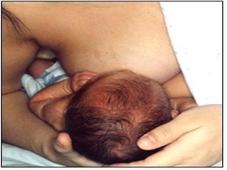
사진 2-72. 유두 전체를 아기 입 속에 다 넣고 아기의 잇몸을 유륜에 대고 모유수유를 한다. 아기가 유두를 물고 늘어지지 않게 아기를 엄마의 가슴에 바싹 추켜 끌어안고 젖을 먹인다. 분만 후 1~2일 동안 젖이 잘 나오지 않아도 시간제로 수유해서 빈 젖이라도 빨리면 유선이 자극되어 젖이 곧 잘 나오게 된다.
Copyright ⓒ 2011 John Sangwon Lee, MD, FAAP
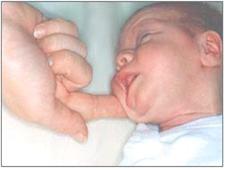
사진 2-73. 루팅 반사
(먹이 찾기 반사/Rooting reflex)
아기의 오른쪽 볼에 손가락을 댈 때 아기는 그쪽으로 얼굴과 몸을 돌린다. 원시 반사의 하나인 먹이 찾기 반사이다.
Copyright ⓒ 2011 John Sangwon Lee, MD ., FAAP
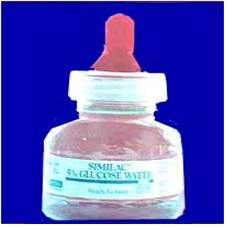
사진 2-74. 신생아 경구용 5% 포도당 액
Copyright ⓒ 2011 John Sangwon Lee, MD., FAAP
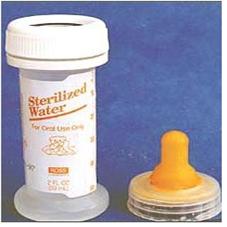
사진 2-75. 신생아 경구용 멸균 맹물
Copyright ⓒ 2011 John Sangwon Lee, MD., FAAP
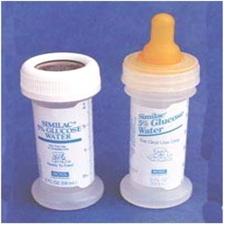
사진 2-76. 신생아 경구용 5% 포도당 액
Copyright ⓒ 2011 John Sangwon Lee, MD., FAAP
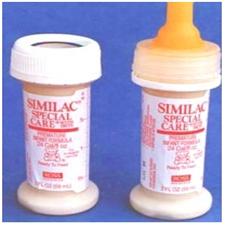
사진 2-77. 인공영양 30cc에 24칼로리 열량이 든 특수 인공영양
Copyright ⓒ 2011 John Sangwon Lee, MD., FAAP
Breastfeeding to newborn infants 신생아에게 모유수유를 할 때

Photo 2-70. Breastfeeding, Eye contact love, breastfeeding while making physical contact. Copyright ⓒ 2011 John Sangwon Lee, MD., FAAP
- If the mother is healthy after delivery and the newborn baby has an sucking reflex and is generally healthy, you can start breastfeeding at any time after birth.
- If possible, she can begin breastfeeding immediately after a natural delivery, even on the delivery table.
- Even a newborn baby with a cesarean section can start breastfeeding right on the operating table.
- After the first start of breastfeeding, breastfeeding can be done on every 2-3 hours.
- Breastfeeding can be done at intervals of 1 to 2 hours at the beginning of breastfeeding, 5 to 7 minutes to feed one breast, and 10 to 15 minutes for both breasts.
- They may breastfeed 8 to 12 times a day in the first few days. The feeding time of one breast is different for each baby, and it depends on the age of birth, the age of the week, or the age of the month.
- There are also times when they breastfeed differently from day to day.
- When breast milk begins to secrete smoothly, the average time it takes to feed one breast is about 10 to 20 minutes, It can take between 20 and 40 minutes to feed both breasts.
- Sometimes the total time required for a single feeding can take a little more than 40 minutes.
- Breastfeeding is also a form of dietary medicine. Breastfeeding cannot be done uniformly according to the formula.
- Even if the milk is not secreted enough during the first 1-3 days of life, breastfeeding on time (schedule breastfeeding) makes colostrum more secreted and the colostrum can be fed to the baby.
- If the baby sucks the nipples on an empty breast while the transitional or mature breast milk is not secreted well, the mammary glands are stimulated and the breast milk can be secreted better.
- Most pediatric and adolescent doctors and breastfeeding mothers emphasize that newborn babies are fed only their mother’s breast milk.
- Emphasize not to feed your baby anything other than mother’s milk. In other words, she stresses that artificial nutrition, formula, 5% glucose for newborns, and plain water should never be fed.
- However, during the first few hours after delivery, sometimes a day or two after delivery, only colostrum is secreted, followed by a little secretion of transitional breast milk, but very little.
- After delivery, the nursing mother may have mental or physical problems or there are many uncomfortable problems without knowing it. In addition, if the newborn is unable to consume enough breast milk for any other reason, supplementation may be used once or twice a day, or for several days, until the breast milk is sufficiently secreted according to the doctor’s instructions, or until the breastfeeding mother’s overall health returns to normal.
- Artificial nutrition (emergency artificial nutrition) can be fed to the baby sensibly.
- The method of feeding artificial nutrition for this purpose is called “saving artificial nutrition diet or supplementary artificial nutrition”. In other words, even at this time, we must make the art of food work. However, if you feed your mother’s breast milk without discrimination and freely feed artificial nutrition, and continue to feed breast milk or artificial nutrition, that is, “mixed feeding,” eight of the tens will no longer be able to continue breastfeeding.
- That is why “mixed feeding is recommended to be avoided whenever possible. In fact, the word “mixed feeding” should not be used. Mixed feeding is actually “confused feeding”.
- It is common for newborns to no longer be able to continue breastfeeding when nutrients are fed to a newborn using the “saving feediong” method. Before embarking on a “saving nutritional diet,”
- it is important to keep in mind that in the future you may no longer be able to breastfeed. During the first few days of life,
- it takes about 10 to 15 minutes to feed once. However, depending on each baby, the amount of time it takes to breastfeed each time can be appropriately adjusted according to the nursing mother, the amount of milk secretion, the baby’s age, that is, the age.
- ([Parents should also be at last the half-doctors-Encyclopedia of Child and Family Nursing)-Volume 4 Breastfeeding, Breastfeeding, Reasons-p Refer to Tips for Feeding a Baby After Delivery)
- Newborns have a primitive reflex that allows them to find and feed mother’s milk from birth I have it. The reflex is called the mammalian reflection (Rooting reflection / Feeding reflection).
- They are born normally with other primitive reflections other than the primitive reflection, the mammalian reflection.
- When it touches a newborn’s lips, mouth, or cheeks, the mother’s nipples, fingers, and rubber nipples are placed in the mouth, and the primitive reflex (rooting reflex) is called the primitive reflex that turns the face and mouth toward the touch to suck it.
- There is a primitive reflex that can suck on the mother’s nipple that has entered the mouth.
- This reflection is referred to as the sucking reflex.
- Because they are born with primordial reflexes such as rooting and sucking reflexes and breast reflexes, newborns and infants after that are ingested with breast milk or artificial nutrition by sucking on the mother’s nipples or milk bottle nipples to ingest nutrients and energy.
- Even newborn babies can smell the milk from their mother’s milk.
- Mom knows the taste of her milk and knows the taste of artificial nutrition. It is fascinating to see birds who cannot see and smell, knowing from outside 1 mile and coming to eat the grains, and it is fascinating to see a newborn baby find and eat mother’s milk. In order to wean a newborn who was only breastfeeding (to wean her), the baby is given artificial nutrition instead of breast milk, and sometimes the artificial nutrition is not fully consumed for several days. In other words, rejection of artificial nutrition may occur.
- The medical community believes that newborns have primordial reflexes to know the smell and taste of their mother’s milk and eat it.
- The milk that has been sucked into the mouth enters the mouth and then into the pharyngeal cavity.
- Then the milk enters the esophagus and then into the gastrointestinal tract. Newborns have a natural-primitive reflex to pass over the sucked milk like this.
- This reflection is called the swallowing reflex.
- The primitive reflex, the breast reflex, the sucker reflex, and the swallowing reflex, which know the smell and taste of breast milk, work in harmony to find the mother’s nipple, suck the found nipple, and suck the milk from the mother’s nipple and pass it into the esophageal canal. do.
- There is nausea and vomiting reflex, which spits out or vomiting when foods that cannot be eaten, foods that are uneatable, or foreign objects that are not foods enter the mouth.
- This primitive reflex also exists from birth to newborns and infants. It is normal for breast milk or artificial nutrients to enter the pharyngeal cavity and then the food to enter the esophagus,
- but it may be accidentally entered into the airways instead of entering the esophagus.
- To get into the airways, you can sneezing, or cough, nausea or vomit, so that breast milk or artificial nutrients no longer enter the airways.
- nausea vomiting reflex works when you try to spit out something you shouldn’t eat. If there is no abnormality after feeding a newborn baby with a few cc of oral sterile plain water or oral 5% glucose solutions for the first time as a test, breast milk or artificial nutrition should be given for the first 1-3 days of life after that.
- It can be fed at intervals of 1~2 hours or every 2-3 hours. Sometimes you can feed it more often. Most newborns usually eat about 60 to 120cc of artificial nutrition every 3 to 4 hours from 3 to 5 days after birth.
- From this time on, newborns and infants gain about 15-20g of weight every day.
- The number of artificial nutrients fed each time should increase with the rate of growth and development of each baby. 85-87% of the ingredients in breast milk or artificial nutrition are water.
- Newborns who are fed breast milk or artificial nutrition do not need to be fed extra water in addition to their special need. When it is suspected that the baby is dehydrated, whether it is in a very hot summer, the room temperature is very high, or the indoor air is dryer than normal, boiled and cooled freshwater or sterilized freshwater for newborns is applied 2-3 times a day. It can be fed with a bottle of milk.
- You can feed plain water in an empty milk bottle between breast milk or artificial nutrition. It is not necessary to feed the newborn with baby food or other foods other than breast milk or artificial nutrition.
- According to the Freudian psychosexual development theory, newborns and infants can instinctively feel psychosexual pleasure when they suck their fingers from birth to their first birthday.
- Most newborn infants are not hungry, but they instinctively suck on almost anything they can wash in their mouths. Just because newborns or infants have eaten enough breast milk or artificial nutrients from birth until the first birthday, put fingers, pacifiers, feet, or anything else in their mouths and suck them hard, so don’t think that the baby is hungry and sucks them.
- Can not be done. [Parents should also become anti-doctors-Encyclopedia of Pediatric Family Nursing]-Volume 4 Breastfeeding Reasons for Breastfeeding and Volume 5 Artificial Nutrition and Baby Food for more information on how to feed newborns and infants with breast milk or artificial nutrition・
- Refer to vitamins, etc. Newborn babies can easily develop vitamin K deficiency.
- This can lead to bleeding throughout the body. Vitamin K injections are routinely given to newborn babies to prevent bleeding that can result from vitamin K deficiency. Since various vitamins are sufficiently contained in artificial nutrition, there is no need to give additional vitamins to babies who eat artificial nutrition.
- Term newborns and infants 4-6 months old who feed on their mother’s breast milk can get enough vitamins from breast milk.
- Babies born at full term who eat a healthy mother’s breast milk who consume a balanced diet usually do not suffer from vitamin deficiency until at least 3-4 months of age.
- From 4 to 6 months of age, infants who are breastfeeding their mother can be fed multivitamins containing vitamins A, C, and D to prevent vitamin deficiency.
- Alternatively, you can take a multivitamin containing various vitamins, iron, and fluoride according to your doctor’s prescription.

Photo 2-71. Put the nipple in the baby’s mouth and place the baby’s gums on the areola to breastfeed.
The baby only bites the nipples and pushes the baby up so that it doesn’t sag, hugs the baby and feeds. If you hold on to the wrong breast, your nipples can hurt.
Round black-brown skin around the nipple roots

Photo 2-72. Put the nipple in the baby’s mouth and place the baby’s gums on the areola to breastfeed. To prevent the baby from biting the nipples and sagging, hold the baby tightly to the mother’s chest, hug it, and breastfeed. Even if the milk does not come out well for 1 to 2 days after delivery, if you breastfeed on a schedule feeding basis and even empty milk quickly, the mammary glands are stimulated and the milk will come out soon. Copyright ⓒ 2011 John Sangwon Lee, MD, FAAP

Photo 2-73. Rooting reflex (Finding reflex food).
When you place your finger on the baby’s right cheek, the baby turns his face and body toward it. It is one of the primitive reflections. Copyright ⓒ 2011 John Sangwon Lee, MD ., FAAP

- Photo 2-74. 5% glucose solution for newborns oral use. Copyright ⓒ 2011 John Sangwon Lee, MD., FAAP

- Photo 2-75. Sterile plain water for newborns. Copyright ⓒ 2011 John Sangwon Lee, MD., FAAP

- Photo 2-76. 5% glucose solution for newborns. Copyright ⓒ 2011 John Sangwon Lee, MD., FAAP

- Photo 2-77. Artificial nutrition. Special artificial nutrition containing 24 calories in 30cc Copyright ⓒ 2011 John Sangwon Lee, MD., FAAP
출처 및 참조 문헌
- NelsonTextbook of Pediatrics 22ND Ed
- The Harriet Lane Handbook 22ND Ed
- Growth and development of the children
- Red Book 32nd Ed 2021-2024
- Neonatal Resuscitation, American Academy Pediatrics
- www.drleepediatrics.com 제1권 소아청소년 응급 의료
- www.drleepediatrics.com 제2권 소아청소년 예방
- www.drleepediatrics.com 제3권 소아청소년 성장 발육 육아
- www.drleepediatrics.com 제4권 모유,모유수유, 이유
- www.drleepediatrics.com 제5권 인공영양, 우유, 이유식, 비타민, 미네랄, 단백질, 탄수화물, 지방
- www.drleepediatrics.com 제6권 신생아 성장 발육 육아 질병
- www.drleepediatrics.com제7권 소아청소년 감염병
- www.drleepediatrics.com제8권 소아청소년 호흡기 질환
- www.drleepediatrics.com제9권 소아청소년 소화기 질환
- www.drleepediatrics.com제10권. 소아청소년 신장 비뇨 생식기 질환
- www.drleepediatrics.com제11권. 소아청소년 심장 혈관계 질환
- www.drleepediatrics.com제12권. 소아청소년 신경 정신 질환, 행동 수면 문제
- www.drleepediatrics.com제13권. 소아청소년 혈액, 림프, 종양 질환
- www.drleepediatrics.com제14권. 소아청소년 내분비, 유전, 염색체, 대사, 희귀병
- www.drleepediatrics.com제15권. 소아청소년 알레르기, 자가 면역질환
- www.drleepediatrics.com제16권. 소아청소년 정형외과 질환
- www.drleepediatrics.com제17권. 소아청소년 피부 질환
- www.drleepediatrics.com제18권. 소아청소년 이비인후(귀 코 인두 후두) 질환
- www.drleepediatrics.com제19권. 소아청소년 안과 (눈)질환
- www.drleepediatrics.com 제20권 소아청소년 이 (치아)질환
- www.drleepediatrics.com 제21권 소아청소년 가정 학교 간호
- www.drleepediatrics.com 제22권 아들 딸 이렇게 사랑해 키우세요
- www.drleepediatrics.com 제23권 사춘기 아이들의 성장 발육 질병
- www.drleepediatrics.com 제24권 소아청소년 성교육
- www.drleepediatrics.com 제25권 임신, 분만, 출산, 신생아 돌보기
- Red book 29th-31st edition 2021
- Nelson Text Book of Pediatrics 19th- 21st Edition
- The Johns Hopkins Hospital, The Harriet Lane Handbook, 22nd edition
- 응급환자관리 정담미디어
- Pediatric Nutritional Handbook American Academy of Pediatrics
- 소아가정간호백과–부모도 반의사가 되어야 한다, 이상원 저
- The pregnancy Bible. By Joan stone, MD. Keith Eddleman, MD
- Neonatology Jeffrey J. Pomerance, C. Joan Richardson
- Preparation for Birth. Beverly Savage and Dianna Smith
- 임신에서 신생아 돌보기까지. 이상원
- Breastfeeding. by Ruth Lawrence and Robert Lawrence
- Sources and references on Growth, Development, Cares, and Diseases of Newborn Infants
- Emergency Medical Service for Children, By Ross Lab. May 1989. p.10
- Emergency care, Harvey Grant and Robert Murray
- Emergency Care Transportation of Sick and Injured American Academy of Orthopaedic Surgeons
- Emergency Pediatrics A Guide to Ambulatory Care, Roger M. Barkin, Peter Rosen
- Quick Reference To Pediatric Emergencies, Delmer J. Pascoe, M.D., Moses Grossman, M.D. with 26 contributors
- Neonatal resuscitation Ameican academy of pediatrics
- Pediatric Nutritional Handbook American Academy of Pediatrics
- Pediatric Resuscitation Pediatric Clinics of North America, Stephen M. Schexnayder, M.D.
-
Pediatric Critical Care, Pediatric Clinics of North America, James P. Orlowski, M.D.
-
Preparation for Birth. Beverly Savage and Dianna Smith
-
Infectious disease of children, Saul Krugman, Samuel L Katz, Ann A.
- 제4권 모유, 모유수유, 이유 참조문헌 및 출처
- 제5권 인공영양, 우유, 이유, 비타민, 단백질, 지방 탄수 화물 참조문헌 및 출처
- 제6권 신생아 성장발육 양호 질병 참조문헌 및 출처
- 소아과학 대한교과서
|
Copyright ⓒ 2015 John Sangwon Lee, MD., FAAP 미국 소아과 전문의, 한국 소아청소년과 전문의 이상원 저 “부모도 반의사가 되어야 한다”-내용은 여러분들의 의사로부터 얻은 정보와 진료를 대신할 수 없습니다. “The information contained in this publication should not be used as a substitute for the medical care and advice of your doctor. There may be variations in treatment that your doctor may recommend based on individual facts and circumstances. “Parental education is the best medicine.” |